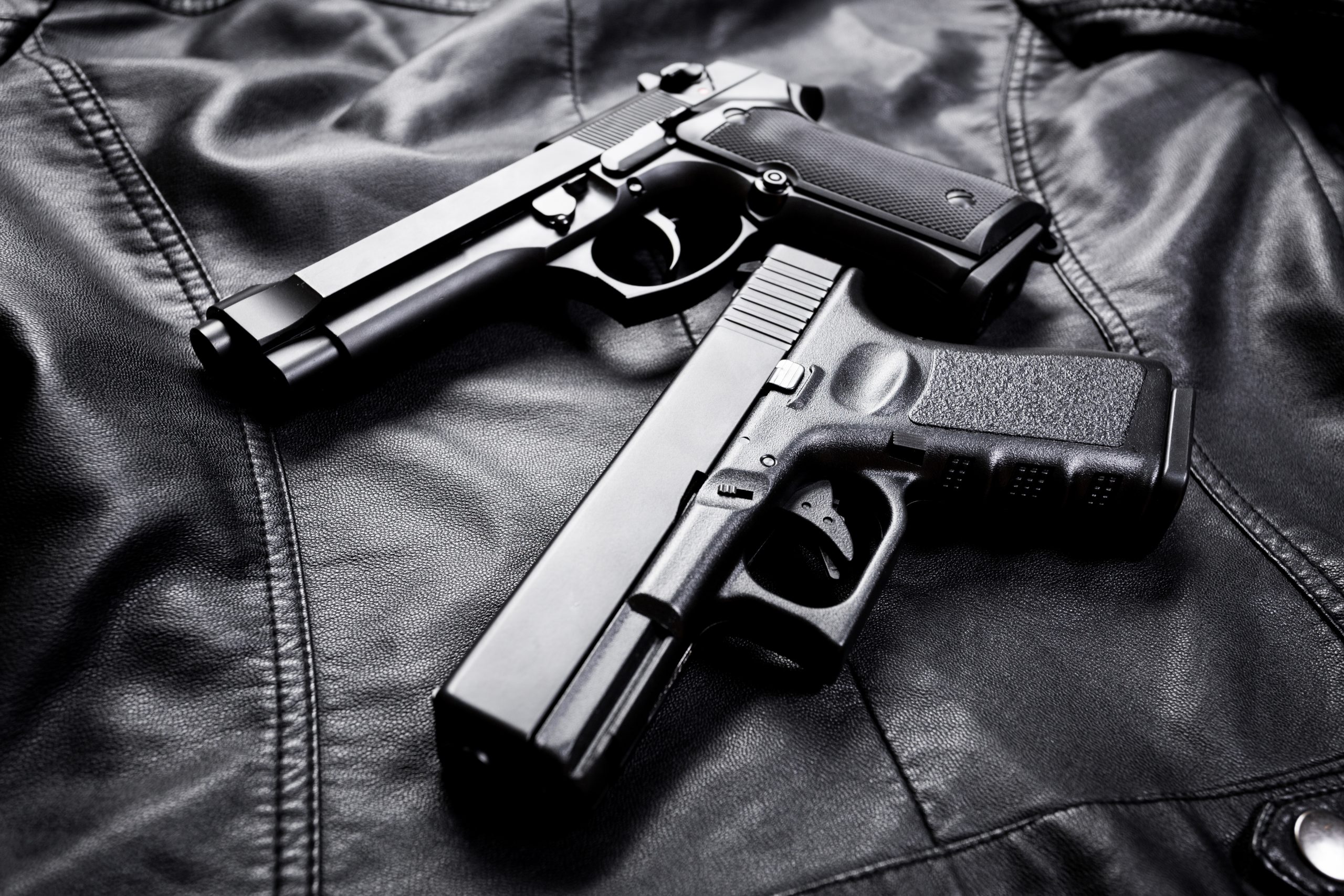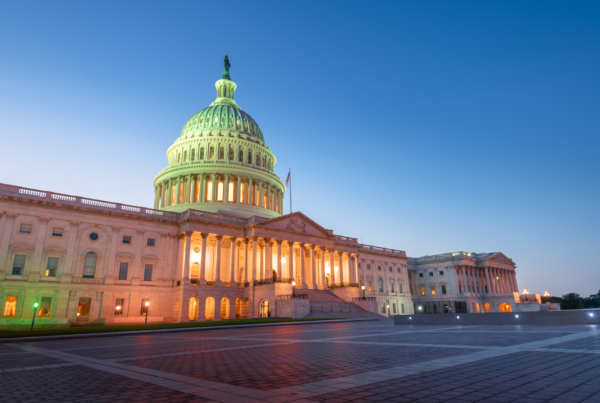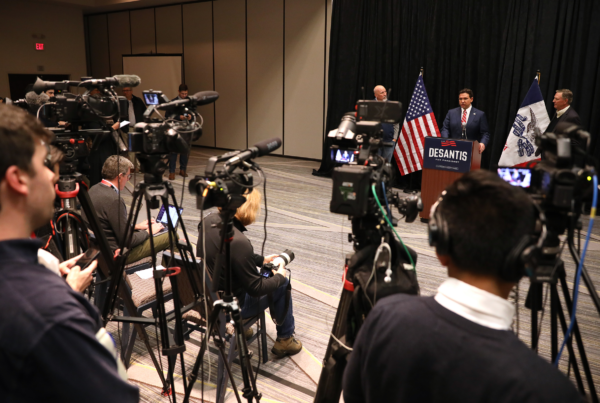12 percent of ads in 2018 election cycle contain a gun reference;
Most are pro-gun rights, but will Parkland be a turning point?
![]()
For our March 2018 election report, click here.
![]()
(MIDDLETOWN, CT) March 15, 2018 – As a national conversation about gun policy in the United States reaches the White House, the Wesleyan Media Project provides a detailed look at references to guns in campaign advertising over time. As shown in Figure 1, the volume and percentage of gun references in advertising mentioning federal or gubernatorial candidates has been increasing since the 2012 election cycle.
More specifically, references to guns appeared in fewer than 25,000 ad airings that also mention federal or gubernatorial candidates for office (one percent of the total number of election-related ad airings) in the 2012 cycle, in just under 91,000 airings (3.4 percent) in the 2014 cycle, and in nearly 190,000 airings (6.2 percent) in the 2016 cycle. So far in the 2018 cycle (including all federal and gubernatorial election airings from January 1, 2017, through March 12, 2018), references to guns have appeared in over 56,000 airings, which represents 11.5 percent of all campaign ad airings. The increase appears to be driven primarily by the special elections for the Alabama Senate seat and the Montana and Kansas House seats where Democratic candidates, in addition to Republicans, were trying to reassure voters that they supported gun rights. (To read more about advertising in the 2018 election cycle, please see our report on top races here).
Figure 1: Volume of gun-related ads and percentage of gun-related ads relative to total airings
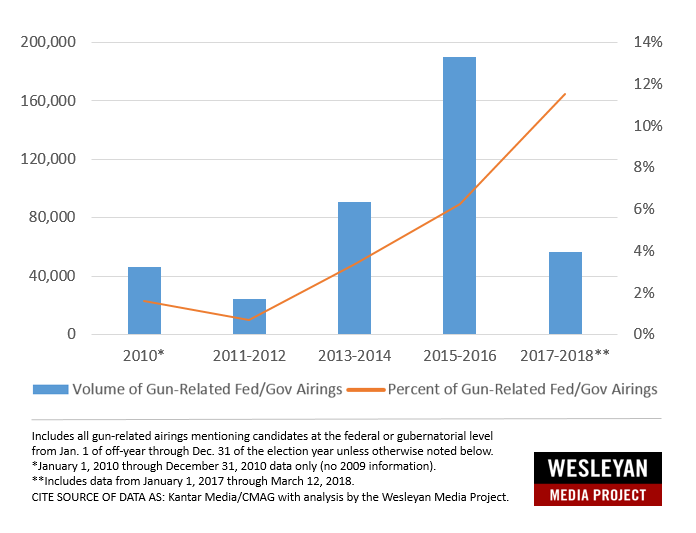
Majority of gun-related ads favor protecting gun rights
Figure 2 shows the volume of gun-related airings by or on behalf of Republican and Democratic candidates (excluding third party airings) that contain an explicit policy position on guns (excluding ads that simply picture or reference guns without a stated position). More specifically, Figure 2 displays the volume and proportion relative to all ad airings devoted to protecting gun rights versus strengthening gun regulations. In 2014, 73 percent of the more than 75,000 ads that mentioned guns took a gun rights position, while in 2016, 70 percent of the over 150,000 ads airing on the topic took a position in favor of gun rights. In the current election cycle, the proportion of ads favoring gun rights was even higher at 78 percent. This percentage will likely change, however, as we are still early in the current election cycle and the majority of ads have yet to air.
The second panel of Figure 2 shows the percent of total ads aired in the cycle that take a position in favor of protecting gun rights versus strengthening gun regulations (the total and percentage will not match Figure 1 as ads for third parties and those that don’t take an explicit position on gun policy are excluded). So far in the 2018 election cycle, nearly 7 percent of ads airing have taken a position favoring protecting gun rights, while only 2 percent have taken a position in favor of strengthening gun regulations. Both percentages, however, are higher than in previous election cycles.
![]()
Figure 2: Policy positions in gun-related advertising, volume and percent of all airings
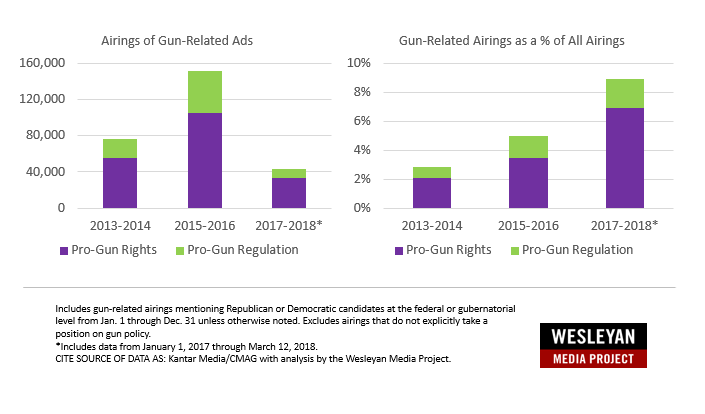
No Clean Party Split on Gun Positions
As shown in Figure 3, while pro-Democratic ads are more likely to express positions in favor of strengthening gun regulations and pro-Republican ads are more likely to express positions in favor of protecting gun rights, those stances are not universal within the party, especially among those advocating for Democrats. A third of ads aired by or on behalf of federal and gubernatorial Democratic candidates in the 2014 cycle featured protection of gun rights positions, and while that percentage declined to just over one in five during the 2016 cycle, the percentage through March 12 of the 2018 cycle was nearly 45 percent. More than 2,200 airings by or on behalf of Republican candidates in 2014 featured language about the importance of strengthening gun laws while over 3,600 airings in 2016 did the same; however, those airings made up only 4.6 and 3.7 percent of the total. In the current 2018 cycle, ads by or on behalf of Republican candidates in federal and gubernatorial races have so far solely featured gun rights positions.
![]()
Figure 3: Volume of Gun-Related Advertising by Cycle, Favored Candidate’s Party Affiliation and Position
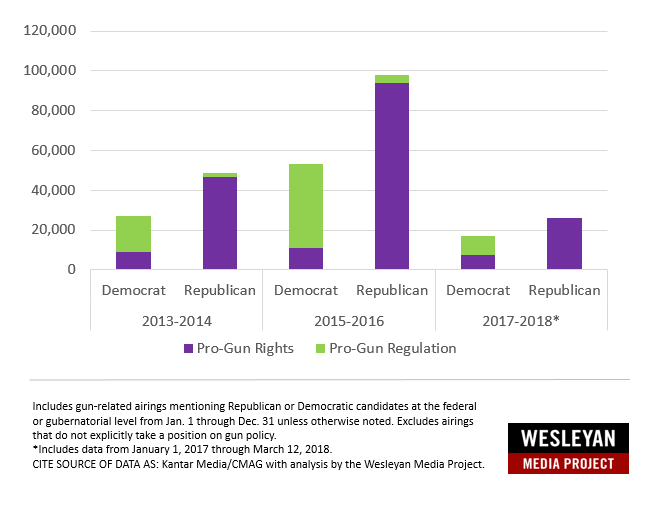
Guns in campaign ads during 2017-2018
As mentioned above, there have been just over 56,000 federal or gubernatorial airings so far in the 2018 cycle that have pictured, mentioned or referenced guns in campaign ads.
Table 1 displays the top groups explicitly taking a position on guns in advertising that also mention federal or gubernatorial candidates for office during this cycle, and the races where they are involved (this list excludes advertising focused on gun issues that do not mention candidates for office like membership ads from the NRA or ads that focus on term-limited politicians like those from Everytown or Giffords PAC).
Table 1: Outside groups advertising in 2017-2018 cycle advocating a gun-policy stance
| Group | Airings | Position | Races Involved |
|---|---|---|---|
| NRA Political Victory Fund | 3,226 | Pro-Gun Rights | AL-Sen, VA-Gov, MT House |
| Senate Leadership Fund | 2,081 | Pro-Gun Rights | AL-Sen |
| All About Florida | 1,451 | Pro-Gun Regulation | FL-Gov |
| Highway 31 PAC | 1,210 | Pro-Gun Rights | AL-Sen |
| NRA Institute For Legislative Action | 668 | Pro-Gun Rights | IN-Sen, MO-Sen, MT-Sen, ND-Sen |
| Hometown Freedom Action Network | 199 | Pro-Gun Rights | SC-05 |
| Giffords PAC | 18 | Pro-Gun Regulation | MN-02, NJ-11 |
| Includes broadcast data from January 1, 2017 through March 12, 2018 for airings with both a stated position on gun policy and that mention a candidate for federal or gubernatorial office. CITE SOURCE OF DATA AS: Kantar Media/CMAG with analysis by the Wesleyan Media Project. |
|||
Little relationship to gun-related events; Parkland may be an exception?
Figure 4 shows the number of ads focused on protecting gun rights and strengthening gun regulations airing each week from January 1, 2017 through March 11, 2018. The vertical lines show the timing of the confirmation vote on Supreme Court Justice Gorsuch on April 7, 2017; the Las Vegas shooting on October 1, 2017; and the Parkland, Florida, shooting on February 14, 2018. By and large, the timing of election ads appears to have little relationship to external gun-related events, though there has been a notable uptick in advertising advocating for strengthening gun regulations following the Parkland shooting. More data from later in this election cycle will reveal if the Parkland mass shooting has a continued impact on the timing, volume or tone of gun-related messages.
![]()
Figure 4: 2018 Election Cycle Volume of Airings by Gun-Policy Position
![]()
About This Report
Data reported here from Kantar/CMAG do not cover local cable buys, only broadcast television, national network and national cable buys. All cost estimates are precisely that: estimates.
The Wesleyan Media Project (WMP) provides real-time tracking and analysis of all political television advertising in an effort to increase transparency in elections. Housed in Wesleyan’s Quantitative Analysis Center – part of the Allbritton Center for the Study of Public Life – the Wesleyan Media Project is the successor to the Wisconsin Advertising Project, which disbanded in 2009. It is directed by Erika Franklin Fowler, associate professor of government at Wesleyan University, Michael M. Franz, professor of government at Bowdoin College and Travis N. Ridout, professor of political science at Washington State University. WMP staff include Laura Baum (Project Manager), Dolly Haddad (Project Coordinator) and Matthew Motta (Research Associate). Key WMP collaborators on this work include: Colleen Barry, Fred and Julie Soper Professor and Chair of the Department of Health Policy and Management at the Johns Hopkins Bloomberg School of Public Health and Jennifer Tucker, Associate Professor of History and Science in Society at Wesleyan University.
The Wesleyan Media Project is supported by Wesleyan University. Data are provided by Kantar Media/CMAG with analysis by the Wesleyan Media Project.
Periodic releases of data will be posted on the project’s website and dispersed via Twitter @wesmediaproject. To be added to our email update list, click here.
For more information contact:
Lauren Rubenstein, lrubenstein@wesleyan.edu, (860) 685-3813
About Wesleyan University
Wesleyan University, in Middletown, Conn., is known for the excellence of its academic and co-curricular programs. With more than 2,900 undergraduates and 200 graduate students, Wesleyan is dedicated to providing a liberal arts education characterized by boldness, rigor and practical idealism. For more, visit www.wesleyan.edu.

